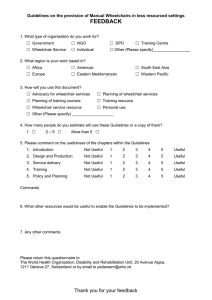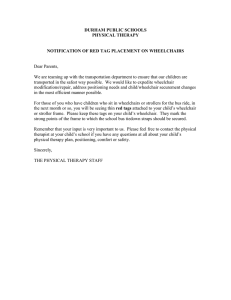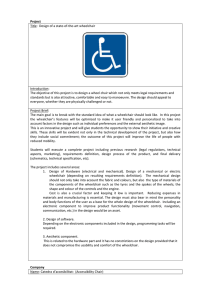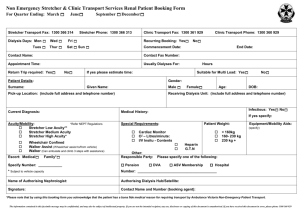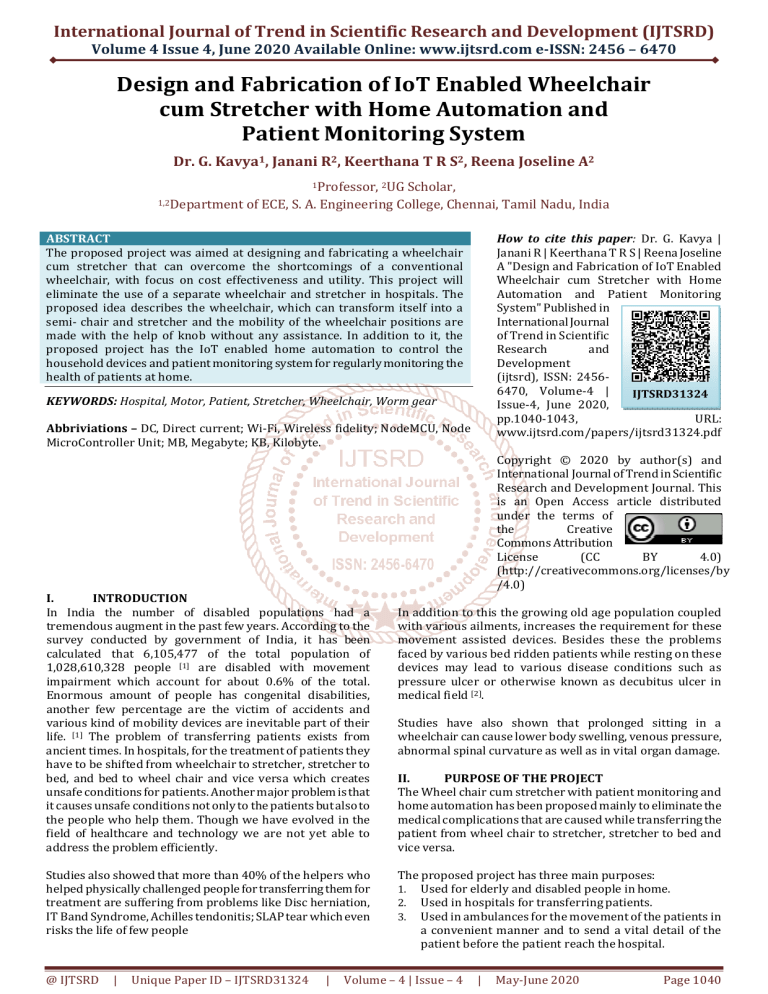
International Journal of Trend in Scientific Research and Development (IJTSRD)
Volume 4 Issue 4, June 2020 Available Online: www.ijtsrd.com e-ISSN: 2456 – 6470
Design and Fabrication of IoT Enabled Wheelchair
cum Stretcher with Home Automation and
Patient Monitoring System
Dr. G. Kavya1, Janani R2, Keerthana T R S2, Reena Joseline A2
1Professor, 2UG
1,2Department
Scholar,
of ECE, S. A. Engineering College, Chennai, Tamil Nadu, India
How to cite this paper: Dr. G. Kavya |
Janani R | Keerthana T R S | Reena Joseline
A "Design and Fabrication of IoT Enabled
Wheelchair cum Stretcher with Home
Automation and Patient Monitoring
System" Published in
International Journal
of Trend in Scientific
Research
and
Development
(ijtsrd), ISSN: 24566470, Volume-4 |
IJTSRD31324
Issue-4, June 2020,
pp.1040-1043,
URL:
www.ijtsrd.com/papers/ijtsrd31324.pdf
ABSTRACT
The proposed project was aimed at designing and fabricating a wheelchair
cum stretcher that can overcome the shortcomings of a conventional
wheelchair, with focus on cost effectiveness and utility. This project will
eliminate the use of a separate wheelchair and stretcher in hospitals. The
proposed idea describes the wheelchair, which can transform itself into a
semi- chair and stretcher and the mobility of the wheelchair positions are
made with the help of knob without any assistance. In addition to it, the
proposed project has the IoT enabled home automation to control the
household devices and patient monitoring system for regularly monitoring the
health of patients at home.
KEYWORDS: Hospital, Motor, Patient, Stretcher, Wheelchair, Worm gear
Abbriviations – DC, Direct current; Wi-Fi, Wireless fidelity; NodeMCU, Node
MicroController Unit; MB, Megabyte; KB, Kilobyte.
Copyright © 2020 by author(s) and
International Journal of Trend in Scientific
Research and Development Journal. This
is an Open Access article distributed
under the terms of
the
Creative
Commons Attribution
License
(CC
BY
4.0)
(http://creativecommons.org/licenses/by
/4.0)
I.
INTRODUCTION
In India the number of disabled populations had a
tremendous augment in the past few years. According to the
survey conducted by government of India, it has been
calculated that 6,105,477 of the total population of
1,028,610,328 people [1] are disabled with movement
impairment which account for about 0.6% of the total.
Enormous amount of people has congenital disabilities,
another few percentage are the victim of accidents and
various kind of mobility devices are inevitable part of their
life. [1] The problem of transferring patients exists from
ancient times. In hospitals, for the treatment of patients they
have to be shifted from wheelchair to stretcher, stretcher to
bed, and bed to wheel chair and vice versa which creates
unsafe conditions for patients. Another major problem is that
it causes unsafe conditions not only to the patients but also to
the people who help them. Though we have evolved in the
field of healthcare and technology we are not yet able to
address the problem efficiently.
Studies also showed that more than 40% of the helpers who
helped physically challenged people for transferring them for
treatment are suffering from problems like Disc herniation,
IT Band Syndrome, Achilles tendonitis; SLAP tear which even
risks the life of few people
@ IJTSRD
|
Unique Paper ID – IJTSRD31324
|
In addition to this the growing old age population coupled
with various ailments, increases the requirement for these
movement assisted devices. Besides these the problems
faced by various bed ridden patients while resting on these
devices may lead to various disease conditions such as
pressure ulcer or otherwise known as decubitus ulcer in
medical field [2].
Studies have also shown that prolonged sitting in a
wheelchair can cause lower body swelling, venous pressure,
abnormal spinal curvature as well as in vital organ damage.
II.
PURPOSE OF THE PROJECT
The Wheel chair cum stretcher with patient monitoring and
home automation has been proposed mainly to eliminate the
medical complications that are caused while transferring the
patient from wheel chair to stretcher, stretcher to bed and
vice versa.
The proposed project has three main purposes:
Used for elderly and disabled people in home.
Used in hospitals for transferring patients.
Used in ambulances for the movement of the patients in
a convenient manner and to send a vital detail of the
patient before the patient reach the hospital.
1.
2.
3.
Volume – 4 | Issue – 4
|
May-June 2020
Page 1040
International Journal of Trend in Scientific Research and Development (IJTSRD) @ www.ijtsrd.com eISSN: 2456-6470
A. Used for Elderly and Disabled People in Home
The wheel chair cum stretcher is developed in such a way that
it can operate in three positions which will be a greatest asset
to the elderly and disabled people in home. It can be operated
by the patients without any assistance and it also plays a major
role in monitoring their medical parameters and also used to
access the home appliances independently by using patient
monitoring and home automation.
According to the analysis more than 50 million adults and
300,000 children have many types of arthritis. It is most
common among women and occurs more frequently as
people get older.
[3] The severe arthritis can result inability to daily activities
and make it difficult to walk. To reduce the difficulties faced
by the people affected by arthritis, wheelchair with three
positions is developed.
The proposed project is also useful for the people affected by
the diseases and disorders like
1. Guillain-Barre syndrome.
2. Non traumatic spinal cord compression.
3. Mentally disabled people.
The main advantages are it will monitor the vital details of
the patient for every second and the data will be collected
from their respective homes and stored for the references of
the doctor to analyze the health condition of the patient.
This will enable the doctors to analyze about the health
conditions of the injured person or patient in advance, so the
doctors with the help of the details obtained, they will set up
all the necessary requirements for the treatment process
before the patients reach the hospitals. Due to this feature,
the death rates can be exponentially reduced.
III.
PRINCIPAL OF WORKING
The proposed project consists of both hardware and software
implementations.
3.1. Hardware Implementation:
The basic model of the wheelchairs which are used in the
Indian hospitals is the base of the proposed model. The
wheelchairs can be restructured in a way that it could operate
in the following three positions.
Wheelchair Position
Semi-chair Position
Stretcher Position
3.1.1. Worm Gear
Figure 1 shows the worm gear interfaced with DC motor is
attached in the construction plays a key role in maintaining
the three fixed position. The patients can control the
positions of the designed wheelchair with the help of a knob
fitted at their arm rest position. The speed controller with the
specification 24V and 60Amps is used in the hardware to
control and regulate the speed of the motor.
B. Used in hospitals for transferring patients
The developed model will play an impeccable position in
hospitals hence it is used for shifting the patient from
wheelchair to stretcher, stretcher to bed, bed to wheelchair
and vice versawithout any assistance. The shifting process
will be easier and it will provide an injury free transportation
of the patients. The attenders who are helping the patient for
shifting from one ward to another, i.e. those who help in the
mobility of the patients are affected by some physical
problems like disc herniation, IT band syndrome, Achilles
tendonitis. To overcome these issues, we can use the
proposed project.
C. Used in ambulances for the movement of the
patients in a convinient manner and to send vital
details of the patients before the patient reach
hospital
In this, mechanical operation of the proposed project plays a
major role, the people who met with an accident may get
fractured or may get injured severely, when the injured
person is in unconscious state, the person who is handling the
injured one, don’t know where they are injured and fractured,
so their handling towards the affected person may cause
more injury over an affected part, it will leads to a breakage
of bones. To overcome these risk factors, the proposed
project is developed with three locked positions chair, semi
chair and stretcher. The three positions are controlled by
knob will avoid the transferring or shifting of the patient from
one position to other.
Figure 1: Worm Gear
3.1.2. DC Motor
Figure 2 shows the DC motor is used to make the prototype
more cost efficient and it is interfaced with the worm gear to
lift a person initially up to 60Kg weight. It can be increased by
using a motor with higher torque. The specification of the DC
motor is 1000rpm, 50kg Torque and 30Amps.
The advantage of the proposed project is that the patient
monitoring fixed in the wheel chair will collect the vital
details of the injured person and will send the collected data
to the hospitals before the ambulance reaches the hospital.
Figure 2: DC Motor
@ IJTSRD
|
Unique Paper ID – IJTSRD31324
|
Volume – 4 | Issue – 4
|
May-June 2020
Page 1041
International Journal of Trend in Scientific Research and Development (IJTSRD) @ www.ijtsrd.com eISSN: 2456-6470
The supply to the motors is given by two 12V batteries. The
mechanism works in such a way that when the knob is
rotated, it automatically instructs the speed controller and
the motor to change the desired positions.
3.2.2. Home Automation System
Figure 5 shows the Home automation system is specifically
designed for the wheelchair cum stretcher which will be used
for the patient and also for the elderly people to operate the
electronic appliances at their home without any assistance.
3.1.3. Speed Controller
Figure 3 shows the DC motor speed controller of
specifications 24V and 60Amps is used to control the speed
of the motor. In the proposed project requires high torque but
while changing the positions from chair to semi-chair or
semi-chair to stretcher, it requires slow movement. In order
to vary the required positions, the speed of the motor is
controlled.
Figure 5: Home Automation System
Figure 3: Speed Controller
3.2. Software Implementation
Node-MCU (ESP8266) microcontroller is used for both
Patient monitoring and Home automations system. The
specification of the Node-MCU is 128KB memory, 4MB
storage and XTOS operating system.
The Blynk app installed in the smart phone acts as the
platform to establish a connection between the home
appliances and mobiles. This results in eliminating the need
for asking help from other people to operate the home
appliances.
IV.
OUTPUT
1. Wheel Chair Position
3.2.1. Patient Monitoring System:
Figure 4 shows the patient monitoring system is attached
with the wheelchair which is used to update the vital
parameters of the patients such as the glucose level, Blood
pressure, heart rate and temperature to the doctors
regularly by storing all the vital data’s in the server of the
hospital.
2.
Semi-Chair Position
Figure 4: Patient monitoring system
The sensors used in the patient monitoring system sends the
vital parameters of the patients to the Node-MCU. Those
parameters are finally stored in a server with the help of the
inbuilt Wi-Fi module in the Node-MCU. If any problem arises
with the patients’ health, the system will give an alert to the
doctors.
@ IJTSRD
|
Unique Paper ID – IJTSRD31324
|
Volume – 4 | Issue – 4
|
May-June 2020
Page 1042
International Journal of Trend in Scientific Research and Development (IJTSRD) @ www.ijtsrd.com eISSN: 2456-6470
3.
Stretcher Position
between each neuron such that the neuron emits 0 to 50
HZ electric signal. By interpreting the signal by
modulation and demodulation, the wheelchair is
controlled.
D. The wheelchair will move to the destination given by the
patient by using GPS technology, this technology is
currently used in driverless cars in various countries.
Conflict of Interest: The authors confirm that there are no
known conflicts of interest associated with this publication of
this paper.
V.
CONCLUSION
In this paper, the proposed model of wheelchair cum
stretcher is operated smoothly with the DC motor and the
worm gear exactly fixes the required position with the use of
knob in the speed controller. Thus, the proposed project is
cost efficiency and the home automation and patient
monitoring system works effectively in both hospitals and the
home of the patients.
VI.
FUTURE SCOPE
A. The Solar panel roof can be used as alternative power
source and also it can be a protective layer from rain and
sun.
B. The wheelchair movement is controlled by combination
of head and voice control system.
C. The wheelchair is controlled by electric signal coming
from brain, there is a certain potential difference
@ IJTSRD
|
Unique Paper ID – IJTSRD31324
|
VII.
REFERENCES
[1] Dr. Ramachandra C G, Shashank S, Ragavendra M J,
Kaushik Ranganath T G, “ Wheelchair cum Stretcher”,
International Journal of Engineering Research and
Technology, Vol.6 Issue 10, Oct 2017
[2] Akhil Sivadas, Christy Joseph Jacob, Ebin Philip, “ An
Evaluation of Wheel Chair Cum Bed Mechanism with
side panel movement for bed”, Vol 2, Issue 11, Apr 2016
[3] “Aging”, Natural Solutions, no.196, Inno Vision Health
Media.Inc.,Aug 2017,p.10
[4] Po Er Hsu ,Yeh Liang Hsu ,Jun Ming Lu1 And Cheng-Hao
Chang, “Seat Adjustment Design Of An Intelligent
Robotic Wheelchair Based On The Stewart Platform”
Regular Paper, Geron technology Research Center ,Yuan
Ze University, Taoyuan, Taiwan,(2013)
[5] Sreerag C S, Gopinath C, ManasRanjan Mishra “Design
and Development of conceptual Wheelchair cum
Stretcher” SAS Tech, (2011), pp. 78-86
Volume – 4 | Issue – 4
|
May-June 2020
Page 1043

